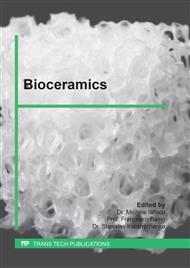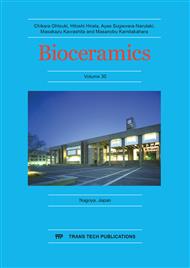p.47
p.53
p.59
p.65
p.72
p.78
p.84
p.91
p.98
Evaluation of Elution Behavior of Silver Ions from Silver-Containing Carbonate Hydroxyapatite Composites
Abstract:
Infection related to orthopedic implant surgeries is one of the significant postoperative complications. Recently, many studies have been conducted on silver-containing hydroxyapatite (AgHA) composites as antibacterial and osteoconductive biomaterials to prevent postoperative infection. In this study, we prepared 1 and 10 wt% Ag-containing carbonate hydroxyapatite composites (1AgCHA and 10AgCHA, respectively) by solid-phase reaction, and investigated the relation between the elution rate of Ag ions from the composites and the chemical or physical states of Ag in AgCHA. X-ray diffraction (XRD) and scanning electron microscopy (SEM) results indicated that metallic Ag particles disappeared in 1AgCHA heated at 800°C, whereas they were distributed in 10AgCHA heated at all temperatures. The amount of A-type CO32- group in AgCHA structure drastically increased at 800°C, but decreased with increasing amount of Ag. The lattice constant (a-axis) of hydroxyapatite expanded drastically when heated at 800°C, and with increasing Ag content, the extent of expansion of a-axis decreased as well as amount of A-type CO32- in CHA. Moreover, after the 48-h elution test, the concentration of Ag+ released from 10AgCHA heated at 800°C was less than 0.1% of total Ag amounts, while 1AgCHA heated at 800°C released over 0.8% of total Ag amounts. The results indicate that Ag+ and CO32- were substituted competitively into the Ca2+ and OH- sites of HA, respectively, after heating at 800°C, and that the elution rate of Ag+ from the sites of Ag+-substituted CHA was faster than that from metallic Ag particles. A better understating of the elution behavior of Ag from AgCHA is important for controlling the physical and chemical states of Ag in composites.
Info:
Periodical:
Pages:
72-77
Citation:
Online since:
October 2018
Authors:
Keywords:
Price:
Сopyright:
© 2018 Trans Tech Publications Ltd. All Rights Reserved
Share:
Citation:



